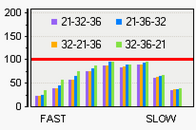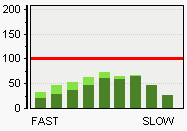A Tale of Three Mixes
Consider the mixes of the OP (21%, 30%, 32% and 36%) and the following four dives, all square profiles with a 30min surface interval between all dives.
Dive 1: 30m, 15min
Dive 2: 25m, 15min
Dive 3: 20m, 15min
Dive 4: 15m, 15min
While I certainly appreciate your analysis, the assumptions seem quite artificial, so I decided to complement your analysis with one of my own using a different set of assumptions which more closely approximate the diving practices of at least a certain subset of divers with which I am familiar.
As the number of possibilities becomes unmanageable very quickly as more dives are added, I'm going to go back to my three-dive trip (based on an actual trip last year). The depths to be visited and the cylinders available were:
Three dives: 110', 90', and 70'
Three mixes: 36%, 32%, and 21%
Three dives and three different mixes give a total of six possibilities, but two would violate the MOD on the first dive:
- 21-32-36
- 32-21-36
- 21-36-32
- 32-36-21
- [-]36-21-32[/-] (violates MOD)
- [-]36-32-21[/-] (violates MOD)
Constraints and Assumptions:
- Each dive begins with one full cylinder holding 77 cubic foot at 3000 psi (Luxfer AL80, rounded from 77.4)
- The diver's SAC is 0.5 cubic feet per minute throughout the dive
- The diver must surface with at least 450 psi ("500" after rounding) remaining
- The diver must not enter deco at any point on the dive
- The diver will remain at depth on each dive as long as possible within the gas-remaining and no-deco constraints
- A one-hour surface interval is completed between dives
- A 3-minute deep stop at half depth, plus a safety stop, are not included in the "Time on Wreck"
The following are the results of simulating the dives in Suunto Dive Manager:
Series 1: 21-32-36:
Time on Wreck:
- Dive 1: 13 min on 21%
- Dive 2: 26 min on 32%
- Dive 3: 38 min on 36% (PSI-limited)
Total: 77 min
Time on Wreck:
- Dive 1: 22 min on 32%
- Dive 2: 17 min on 21%
- Dive 3: 38 min on 36% (PSI-limited)
Total: 77 min
Time on Wreck:
- Dive 1: 13 min on 21%
- Dive 2: 30 min on 36%
- Dive 3: 37 min on 32%
Total: 80 min
Time on Wreck:
- Dive 1: 22 min on 32%
- Dive 2: 29 min on 36%
- Dive 3: 25 min on 21%
Total: 76 min
The following is a combined final tissue saturation graph of all four series:

All four series avoided deco and surfaced with a "boat's rule" of air remaining. While I certainly do not begrudge anyone of placing additional constraints on their diving (I do in mine), the constraints listed are common and while they are not necessarily "conservative", they are not untenable.
I would suggest, then, that the particular tissue saturations in the graph above are not significant to the decision of which mix to dive on which dive in the given three-dive sequence. Any decision within the constraints (e.g. MOD) is *acceptable*, so which order is *optimal*? *THAT* should be the question, and it is not a question that pure data can answer. So, what of it?
Well, of considerable note to me is that diving 32% instead of 21% on the first dive increases that dive's length by just shy of 70%! Adding an additional 9 minutes to a 13-minute dive is quite significant to me. A 22-minute dive may give me time to peruse the entire wreck without feeling rushed, and that 9 minutes of theoretical time will only stretch more given the non-square bottom of the real dive.
If I decide I want that time, then I've got to choose from Series 2 or Series 4. If I do air for the second dive, I'd only get 17 minutes on it, whereas if I go with my 36%, I can get 70% longer, again -- 29 minutes. Of course, there's a cost to everything, and that cost is that I significantly shorten my third and final dive. Instead of getting 38 minutes, I can only stay a more modest 25 minutes. For me, however, a 25-minute dive is not unacceptably short. (As a third dive, if I'm feeling chilled or seasick, it may be longer than I need, regardless.)
In the case of my trip, the third dive was going to be on a near-shore site I'd been to plenty of times before, so I had absolutely no reason to hesitate to trade time on it for time on the other less-traveled sites. Each of my dives in Series 4 is in the 25 +/- 5 minutes range, which seems like a decent way to split the time. If I went with Series 1, I'd have a short, medium, and long dive, which may be more to my liking if there's chilly water below the thermocline on the deep sites. If I wanted more time at both of the shallower sites (for photography, perhaps), I could dive Series 3 and have two extended dives and one shorter.
So, basically, what is the "correct" order to dive the mixes? There isn't one. Sure, you can end up with a bit lower nitrogen loading at the end of the series of you dive one way versus another, but if you stay within your constraints *any* of the available options are acceptable. It all comes down to what you want to get out of the dives.
(Don't fall for the "lower nitrogen loading is *better*" concept. If you take that too far, you end up giving up diving completely and moving to Denver or something like that. Your nitrogen loading should be kept at acceptable, non-DCS-producing levels, certainly, but it need not be your focus of optimization.)






